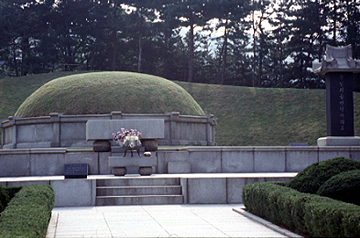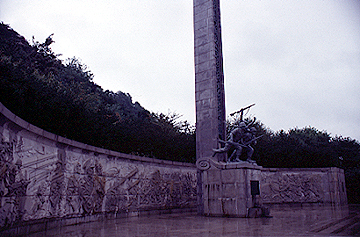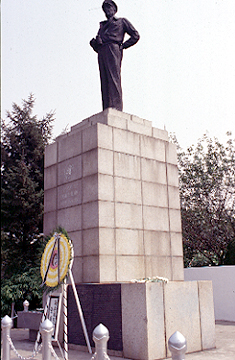
TAKE A LOOK AT PHOTOS OF THE 1960 STUDENT REVOLUTION MEMORIAL (4.19 myo-ji)...
 |
..This is the grave of Yi Seung-man (Syngman Rhee). He was the first president of the Republic of Korea. A controversial figure, Rhee was the U.S. Military Government's choice for leader of the South in the late 40's, and only because he was one of the few anti-communist Korean political leaders around. He ruled as an autocrat. He justified his style of rule as necessary in the face of the North Korean threat, setting a precedent for all other Korean presidents to follow. He was extremely unpopular in Korea by the time he resigned as a result of the April, 1960 Student Revolution. He died in exile in Hawaii in 1965. TAKE A LOOK AT PHOTOS OF THE 1960 STUDENT REVOLUTION MEMORIAL (4.19 myo-ji)... |
| There are dozens of Korean War-era memorials one can see around the country. This is the Inchon Landing memorial in Inchon. It commemorates the amphibious landing by U.S. and Korean Marines on September 15th, 1950. Some say the 'surprise' landing caught the North Korean Army (Inmingun) off guard, but actually they knew the attack had been coming for at least a week before it took place. By the time the landings took place, less than 3 months after hostilities began, the U.S. alone had already suffered 20,000 casualties, with 4,280 dead. The Bad Old Days | 
|
 |
..A statue of Douglas MacArthur stands looking out over modern Inchon Harbor. MacArthur was a dangerous warmonger who wanted to drop atomic bombs on China, and that was one reason why Truman fired him (in addition to criticizing the president's leadership!) |
| This is a memorial north of Seoul for the First Battalion of the Gloucestershire Regiment of the British Army that made a heroic holding action on a hilltop in April of 1951. After the battle, 169 out of 850 Gloucesters were left, the majority of the others were captured, wounded, or dead. | 
|
 |
..a detail of the monument. |
| A statue of a memorial at the foot of the Chiri Mountains in southern Korea. It's dedicated to the Korean Army and National Police forces that suppressed South Korean communist partisans in the late 40's. Again in the 50's, North Korean soldiers fled into the Chiri mountains and held on until a year after the Korean War was over. | 
|